Link Roundups feature articles and bits of internet goodness that our dramaturgy team digs up. If you find something you want to send our way, drop us a line on Facebook or Twitter!
♦♦♦♦♦
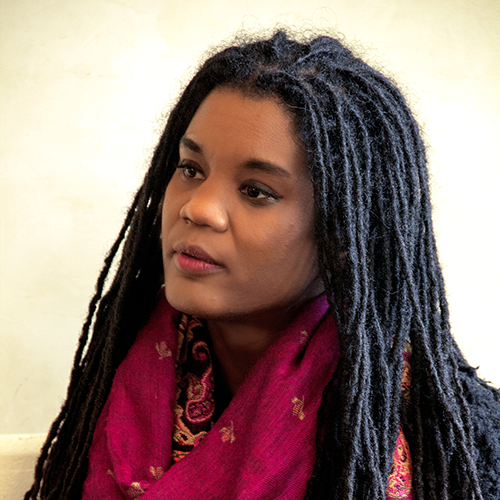
Playwright Chisa Hutchinson, who recently received a Dramatist Guild award for early career playwriting, has an interview on The Interval about the development of her work and the representation of women and non-white writing in the theatre:
Q: How do you think theater can better address race?
A: To give room to everyone. It’s hard for me to listen to people who literally cannot imagine the experiences of other people and therefore dismiss those experiences like, “No, of course that doesn’t happen. This is post-racial America.” Can we just make room for other experiences? Or just acknowledge that there are experiences different than yours?
♦♦♦♦♦
It’s Native voices week on HowlRound and the site is featuring essays from various Native American artists, including this thoughtful piece by Larissa FastHorse:
Do white playwrights ever think about this? Do they worry about losing jobs for white actors? Do they question if they are writing about enough white issues? Are they expected to be the voice of all white people even when they are just speaking for themselves? Do they fear their play about a girl who wants to be a ballet dancer is responsible for the genocide of their race?
Continue reading →
Link Roundups feature articles and bits of internet goodness that our dramaturgy team digs up. If you find something you want to send our way, drop us a line on Facebook or Twitter!
♦♦♦♦♦
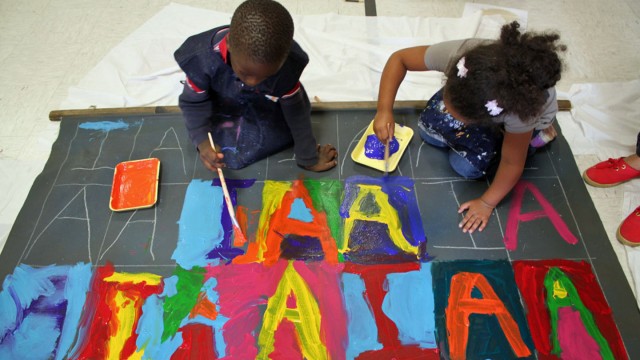
Kindergartners at Wheeler paint the backdrop for their school photos. (Courtesy of Ada Leaphart/Integrated Arts Academy at H.O. Wheeler)
This piece about the Integrated Arts Academy in Vermont combining the arts with math, science, social studies and other curriculum really highlights the importance of creativity in the classroom:
What does art integration look like? Recently, a fourth-grade lesson on geometry examined the work of the famous Russian artist Wassily Kandinsky. The class talked about his work and then created their own art using angles in the style of Kandinsky. Students had to be able to identify the angles they’d used and point them out in their art.
“Higher analytical thinking and reasoning and student voice fit so well with the arts,” said Bobby Riley, the school’s principal. Teachers are seeing ways to make connections between subjects and watch as students find creative confidence and voice in their expression.
♦♦♦♦♦
The Boston Globe has an interview with Julie Burros, the new arts and culture chief, about her plans for Boston and what she’s learned about the city’s cultural scene since taking office:
On the relationship between the arts and income inequality, I’m curious to know: Can you use arts and culture to address that growing problem?
Maximizing people’s creative capital could help create income opportunities for people who maybe don’t see themselves fitting into the four-year college track or the corporate world. There’s another relationship in, how can unlocking people’s creative tools help them be more employable, more well-rounded employees for all different kinds of industries? And then there’s just the appeal factor. If we have more robust arts and culture offerings in our schools, it could keep kids in school longer.
Continue reading →
Link Roundups feature articles and bits of internet goodness that our dramaturgy team digs up. If you find something you want to send our way, drop us a line on Facebook or Twitter!
♦♦♦♦♦
Three new reports from the NEA were recently released and explore the relationship between arts and the economy and detail how audiences attend and participate in the arts. Check them out, data nerds!

♦♦♦♦♦
Everyday Feminism has a great post about what intersectionality means and why it’s so important. It’s a great tool for anyone wondering how to explain inclusive feminism and apply it day-to-day.
It makes sense in many ways that those of us with identity privilege would have a harder time including in our feminism those who are oppressed. Privilege conceals itself from those who have it, and it’s a lot easier to focus on the ways that we are marginalized or oppressed.
But without an intersectional lens, our movements cannot be truly anti-oppressive because it is not, in fact, possible to tease apart the oppressions that people are experiencing. Racism for women of color cannot be separated from their gendered oppression. A Trans person with a disability cannot choose which part of their identity is most in need of liberation.
Yet there is regularly confusion about what intersectionality really is.

Continue reading →
Since we produced the three plays in the DISPLACED HINDU GODS TRILOGY in two spaces in the BCA Plaza Theatre, we were able to fully transform the lobby into a fun, interactive, informative space.
- – Video stations with clips that tell the stories of intersex individuals
- – Re-mythologized shrines
- – Cosmic audience response board with the following questions:
- BRAHMAN/I: What stories helped shape your identity, or gave you insight into who you are?
- KALKI: What happened when you stepped out of the circle of protection?
- SHIV: What have you had to destroy or leave behind in order to move forward?
- TRILOGY: What else do you want to tell us?
- – Modernist Indian (magnetic) poetry board
- – Contextual video wall
Check out the photo album from opening night to see audience members and the creative team exploring and celebrating in the lobby!
-
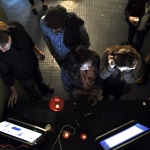
-
Video stations
-

-
Video stations
-
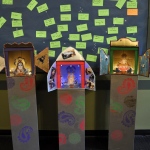
-
Re-mythologized shrines
-

-
Modernist Indian magnetic poetry
-

-
Audience response bulletin board
-
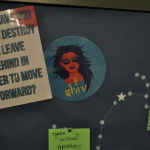
-
SHIV prompt
-
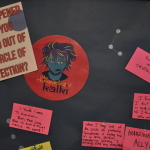
-
KALKI prompt
-
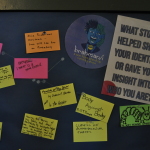
-
BRAHMAN/I prompt
-

-
Bookstore
Staff chat posts feature articles and news that the C1 team discusses as part of our weekly all-staff meeting. We’d love to hear your thoughts too — hit us up on Facebook or Twitter!
♦♦♦♦♦
Believe it or not, the C1 team is already gearing up for our upcoming summer show, COLOSSAL by Andrew Hinderaker! To prep for our early conversations about the play, we’ve been looking for resources about accessibility. It’s important for all of us to feel comfortable with the language we’re using as we head into the audition, workshop, and production process for the play. This week, the staff is looking at a few articles and tips for interacting with people with physical disabilities:
One thing that’s key is making sure you’re using person-first language — language that puts the focus on the individual, rather than on a disability. Here’s a helpful chart!
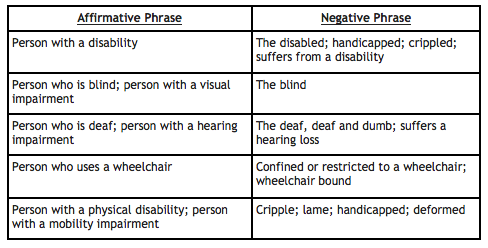
As Zachary Fenell, the author of this article from Huffington Post writes:
No matter the word you use, aim to showcase the person. Ideally a person’s name will always come before his or her condition. So I’m Zachary Fenell, an author with cerebral palsy. Not, an author with cerebral palsy, Zachary Fenell. Introducing name first, condition second will maintain a person-first narrative.

Margaret Keller (l), executive director of Community Access to the Arts, applauds along with teachers and students after a poetry reading in Pittsfield, Mass. last July. CATA provides access to visual and performance arts to people with disabilities
Continue reading →
Staff Chat posts feature articles and news that the C1 team discusses as part of our weekly all-staff meeting. We’d love to hear your thoughts, too — hit us up here in the comments, or on Facebook and Twitter!
♦♦♦♦♦
While C1 was busy opening our Displaced Hindu Gods Trilogy by Aditi Kapil over the past few weeks, some exciting announcements about the state of Boston’s cultural community were released. The staff is reading a few articles this week to catch up on the news – check out the links below:
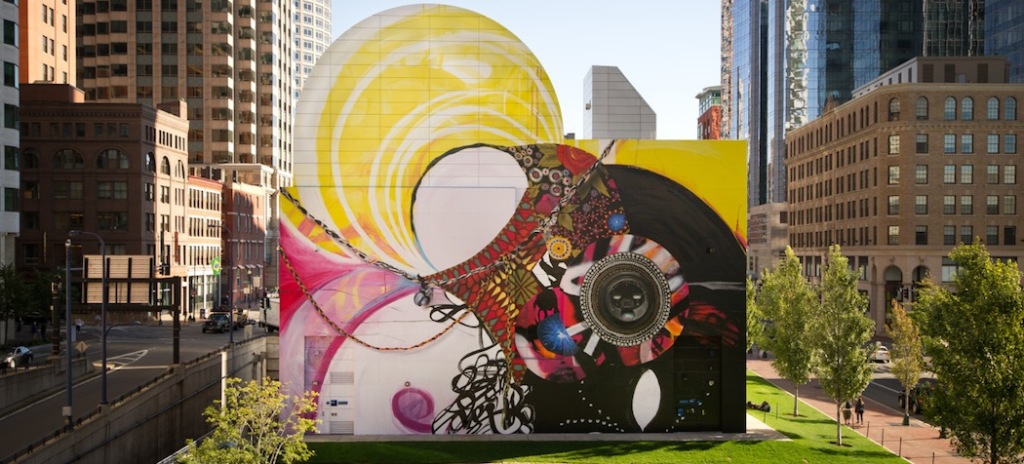
“Seven Moon Junction” by Shinique Smith, the Greenway Wall in Dewey Square
Continue reading →
We’ve been researching a metric ton of literature on community/arts partnerships for the last few weeks, and we think we’ve finally found some good material.
Here are two reports.
The first one is called Arts & Non-Arts Partnerships: Opportunities, Challenges, and Strategies.
It addresses:
– Mutual Benefits of Community Partnerships
– The Connections of Non-arts Organizations to the Arts
– Partnership Assets Can Also Be Liabilities
– Understanding the Risks
– Types of Partnership Risks
The second item is Partnership as an Art Form: What Works and What Doesn’t in Nonprofit Arts Partnerships. We recommend in particular the section called “Part I: How to Think About Partnerships,” and can be found on numbered pages 9-12 (pages 10-13 of the pdf file).
These readings provide some background to the how and why of arts & community partnerships, and can lend guidance on how theatres might think about possible collaborations for individual plays, or season initiatives.
This article by Scott Palmer, artistic director of Bag&Baggage in Hillsboro, OR, talks about how their recent grant from Met Life/TCG’s A-Ha Program: Think It, Do It, enabled them to connect with communities unaccustomed to theatre. They discovered how the language they use to talk about their company is hitting their rural neighbors to the west in addition to other discoveries they’ve made in their research. Read the article here.
This article talks about a letter that Makoto Hirano, a self-described “dance theater artist, actual Japanese person, [and] actual Samurai descendant,” wrote to the Lantern Theatre Company Artistic Director, Charles McMahon, after watching the theatre company’s production of Julius Caesar. McMahon also wrote a letter in response to Hirano. Read the article here.
This series on HowlRound talks about Mixed Blood Theatre’s Radical Hospitality program, which was started in September 2011 to give audiences more accessibility to theatre. This discussion is curated by Aditi Kapil (Love Person), who is also Mixed Blood Theatre’s playwright-in-residence. Read the discussion here.
















